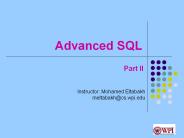aX ODBC Features - PowerPoint PPT Presentation
1 / 16
Title:
aX ODBC Features
Description:
To use ODBC, you need to create a Data Source Name (DSN). aX ODBC Basics V01/0901 ... First we have to create a DSN ... Select the DSN created before (AXODBC ... – PowerPoint PPT presentation
Number of Views:69
Avg rating:3.0/5.0
Title: aX ODBC Features
1
aX ODBC Features
OpenDataBaseConnectivity
Understand what ODBC is all about and how it is
used. Do the Software-Setup on your operating
system and aX. Know which ODBC functions are
available in aX. Solve problems caused by
connection failures.
- Training aX Basics
2
aX-ODBC Overview
- Introduction to ODBC
- ODBC Client/Server Architecture
- Structured Query Language (SQL)
- ODBC configuration on Windows NT
- ODBC configuration on automationX
- ODBC functions Conn, Read, Add, Update, Delete
- Exercise Read a data set from a specific table
- Troubleshooting
3
Introduction To ODBC
- ODBC is an acronym for Open Data Base
Connectivity. - It is a standardized set of application
programming interface (API) that can be used to
access data stored in database management systems
(DBMS). - ODBC uses a client / server model which can be
used on one host or across the network. - To use ODBC, you need to create a Data Source
Name (DSN).
4
ODBC Client/Server Architecture
For a connection to a DBMS, you need
5
Structured Query Language
- SQL stands for Structured Query Language.
- SQL is an invention of IBM.
- The official standard is called ANSI SQL92.
- SQL is text based and easy to use.
- SQL is implemented in the most DBMS systems.
- SQL is the data protocol between ODBC and the
DBMS.
6
Structured Query Language
- SQL stands for Structured Query Language
- SQL is an invention of IBM
- The official standard is called ANSI SQL92
- SQL is text based and easy to use
- SQL is implemented in the most DBMS systems
- SQL is the data protocol between ODBC and the DBMS
7
ODBC Configuration on Windows NT
- First we have to create a DSN
- Invoke the ODBC Data Source Administrator on the
Control Panel by double clicking the 32bit ODBC
icon. - Next, select the System DSN tab.
8
ODBC Configuration on Windows NT
- First we have to create a DSN
- Invoke the ODBC Data Source Administrator on the
Control Panel by double clicking the 32bit ODBC
icon
9
ODBC Configuration on Windows NT
- Click on the Add Button and select the
corresponding driver to your database (e.g.
Microsoft Access Driver ) - In the ODBC Configurator window (e.g. ODBC
Microsoft Access Setup, depending on the DBMS
used) enter a DSN (e.g. AXODBCSample)
10
ODBC Configuration on aXStep 1
When creating a new ODBC variable the ODBC Wizard
appears
- Select the DSN created before (AXODBC Sample).
- Login
- From the underlying tables, select the table,
procedure or view you want to use. - Click Next to open the second window of the
ODBC Wizard.
11
ODBC Configuration on aXStep 2
- Enter the desired
- table row count.
Click Finish
12
ODBC Configuration on aXStep 3
- Enter a variable name
Enter all variable flags and parameters as
you need
13
ODBC functions Conn, Read, Add, Update, Delete
- automationX provides the following ODBC function
blocks - ODBCConn to establish a single line connection to
DBMS. - ODBCRead to query data from DBMS.
- ODBCAdd to append data to DBMS.
- ODBCUpdate to change existing data sets.
- ODBCDelete to delete specific data sets.
14
Exercise read a data set from a specific table
- Insert a ODBCRead from automationX library
Number of read datasets
If an error is pending, err is set to 1
active is set during an DBMS read
Time in ms spent in the DBMS operation
- Connect the ODBC variable to the ODBCTable
Input. - Create an SQL Query if needed, otherwise leave it
open. - If trigger is set to 1, one read operation will
be performed. - If logger is set to 1, all errors will be
logged in the Journal under ODBC. - If dbg is set to 1, all errors will be
reported in an online debug window.
15
aX-ODBC Troubleshooting
- The ODBC function block remains activated for an
infinite time - Make sure the axodbcserver is enabled in
UserProcesses
- The ODBC function block reports an error
- Make sure the logger input is set to 1.
- If the logger input is set, all errors are
reported in the ODBC journal. - For detailed information use the NT/2000 ODBC
logger.
- The ODBC driver reports that no more
connections are valid - Use the ODBCConn function block to create a
single connection to the DBMS.
16
Reference Material
- Reference material can be found on our web-site
www.automationX.com - in automationX System Manual, chapters
- Function Block Classes
- Tools and Extended Functions
- in Support gt Technical FAQs
- The practical SQL Handbook, Addison - Wesley
- ODBC 3.5 Developers Guide, McGraw-Hill
End
End































